

Council for Aid to Education — CLA+ Student Guides. What is the CLA+?
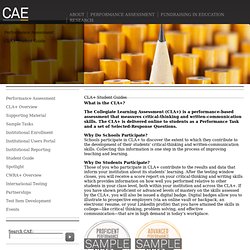
The Collegiate Learning Assessment (CLA+) is a performance-based assessment that measures critical-thinking and written-communication skills. The CLA+ is delivered online to students as a Performance Task and a set of Selected-Response Questions. Why Do Schools Participate? Schools participate in CLA+ to discover the extent to which they contribute to the development of their students’ critical-thinking and written-communication skills.
12 Steps to Creating a Successful Redo and Retake Policy. Implementing redos and retakes takes extra time and effort, but the following guidelines minimize teacher effort and maximizes student learning. 1.
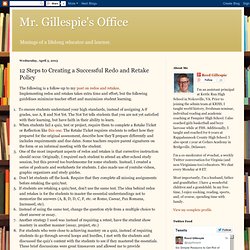
To ensure students understand your high standards, instead of assigning A-F grades, use A, B and Not Yet. The Not Yet tells students that you are not yet satisfied with their learning, but have faith in their ability to learn. Increasing Student Engagement By Grading Backwards. Good Morning.

You All Have An F: Increasing Student Engagement Via An Additive Grading System by Rob Steller, classxp.org In a way, the current education system is already set up like a game–just not a very well designed one. Students earn points (grades), gain levels (grades), and in a way, have leaderboards. There are class valedictorians and students are essentially ranked based on their grades when colleges are deciding who to accept. Grading vs. Assessment of Learning Outcomes - Enhancing Education. There is often confusion over the difference between grades and learning assessment, with some believing that they are totally unrelated and others thinking they are one and the same.
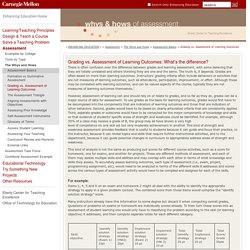
The truth is, it depends. Grades are often based on more than learning outcomes. Instructors’ grading criteria often include behaviors or activities that are not measures of learning outcomes, such as attendance, participation, improvement, or effort. Although these may be correlated with learning outcomes, and can be valued aspects of the course, typically they are not measures of learning outcomes themselves.1 However, assessment of learning can and should rely on or relate to grades, and so far as they do, grades can be a major source of data for assessment.
This kind of analysis is not the same as producing sub scores for different course activities, such as a score for homework, one for exams, and another for projects. For example: CONTACT US to talk with an Eberly colleague in person! OConnorKen1. Grading For Learning Final. Grading For Learning Final. Transitioning to Standards Based Grading: Retakes and No K's. I have had several teachers approach me over the past month asking about Standards Based Grading.
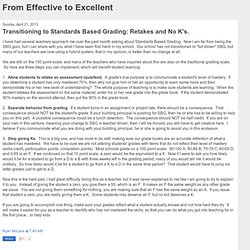
Now I am far from being the SBG guru, but I can share with you what I have seen first hand in my school. Our school has not transitioned to "full blown" SBG, but many of our teachers are now using a hybrid system, that in my opinion, is better than no change at all. We are still on the 100 point scale, and many of the teachers who have inquired about this are also on the traditional grading scale.
So here are three steps you can implement, which will benefit student learning: 1. 2. 3. Now this is the hard part, I had great difficulty doing this as a teacher, but it was never explained to me like I am going to try to explain it to you. Reflections of a Type-A Teacher. In the subheading of this blog I refer to this school year as my “second year of teaching high school math” but that is not entirely true.

I taught for three years at a private New Hampshire boarding school before going back for my teaching certification. This is really my fifth year of teaching, but only my second year as a certified public school teacher. I separate the experiences because of how much I changed as a result of my teacher training program. I was particularly influenced by two authors, Grant Wiggins and Rick Wormeli. My planning, practices, instruction and assessments will never be the same. And my grading policy – my grading policy will never be the same. The purpose of a grade is to show how much of the course-material has been mastered. “So we don’t have to do the practice?!!?!!” You get the idea. Tom Schimmer. Zeros don’t work; never have, never will!
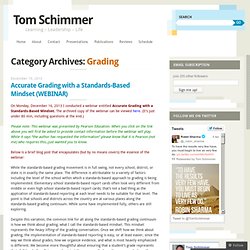
While a good number of schools/districts have already addressed this issue through a shift in policy or practice, two questions come to mind: (1) Why hasn’t everyone, and (2) What took us so long? For some of us, our reaction to this post would be, “Ya we know that already. We did ‘no zeros’ three years ago!” However, the knowing-doing gap is still alive and well in some places which is why I think the topic is still important to discuss. Now before I go on about zeros, let me first tell you that early in my career I was the zero guy.
What I’m talking about is the practice of assigning “0” for work that has not been handed in. It’s not accurate: In most cases, “0” reflects what the student hasn’t done, not what the student knows. Pearson Teacher Education and Development: Ten Things that Matter from Assessment to Grading.